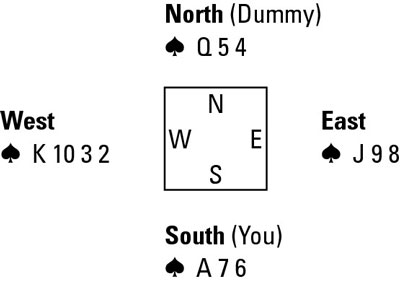When you want to take tricks with lower honor cards, such as the king, queen, or jack, you need to lead from the side opposite the honor card with which you want to take a trick. Think of leading from weakness toward strength.
If you want to take a trick with a queen, do her a favor and lead toward her; she may be able to escape the clutches of the king. This image shows you how the queen can elude the king.

You want to take a trick with your ♠Q, but you don’t know who has the ♠K. (Yes, you can see the ♠K in East’s hand in the image, but if you were playing for real, you couldn’t see that ♠K unless you were Superman.) Here’s how this hand might play out:
-
You lead a low spade from the dummy, the ♠2.
Remember, with a finesse, you want to go from weakness toward strength. East, the second to play after the lead, usually plays his lowest card, the ♠4, so as not to give away any information about his hand.
-
You, South, play the ♠Q, which wins the trick.
Your finesse works.
This image shows another very common finesse involving the queen. This time, the ♠Q is in the dummy separated from her guardian, the ♠A.
Begin by leading a low spade, the ♠6, from your hand, the hand opposite the ♠Q. You’re hoping that West, the second hand, has the missing honor, the ♠K. In this case, West does have the ♠K. West has a couple of play options:

-
If West plays a low spade, the ♠2, you take the trick with the ♠Q.
-
If West takes the trick with the ♠K, your ♠Q becomes a later trick.
How to finesse a king by an ace
This image shows a classic finesse position. You have the ♠K in the dummy; your opponents have the ♠A. You want to take a trick with the ♠K.
Lead a low spade from your hand, the ♠3, from weakness toward strength. West happens to have the ♠A, so she can make one of two moves:
-
If West plays the ♠A, your ♠K becomes a later sure trick because the king is now the highest-ranking remaining card in the spade suit.
-
If West plays a low spade, the ♠8, you play the king and take a trick immediately with the ♠K.
Now check out this image, which presents a scenario just as likely as the one in the preceding image.

When you lead a low spade, the ♠3, and then play the ♠K in the dummy, East (the last to play to the trick) takes your ♠K with the vA. Your ♠K doesn’t take a trick. Your finesse has lost.
Don’t grieve — a finesse loses about half the time. Everyone thinks that their finesses always lose while the opponents’ finesses always win. It’s just a temporary pain. Successful finesses even out over the long haul.
How to finesse against split honors
Sometimes your opponents have two important honors in the suit that you want to attack in a hand of bridge. If those honors are split and each opponent has one honor, you can finesse those split honors, so you’re playing for split honors.You have a chance to play for split honors with the cards shown in this image, a hand where you can take two finesses.

In this image, you have a powerful three-card honor combination in the dummy: the ♠AJ10. You normally attack suits with powerful honor combinations early. Because you’re missing both the ♠K and the ♠Q, two important honors, assume that the honors are split between the two opposing hands:
-
Start by leading a low spade from your hand, the ♠5, weakness to strength.
West, second to play, sees that the dummy has a higher spade, the ♠A, than West has with the ♠K, so West properly plays low, the ♠3.
-
You insert the ♠10 from the dummy.
East wins the trick with the vQ, as expected (split honors, remember?). Hang on, though; it ain’t over ’til it’s over.
-
After you regain the lead in another suit, you lead another low spade from your hand, the ♠6.
Once again, West properly plays low, the ♠4.
-
You insert the ♠J from the dummy.
Success! Your second finesse has worked. The missing spade honors were split after all (the ♠K in one hand and the ♠Q in the other). And you have a little bonus in store, to boot.
-
Take the next trick by playing the ♠A.
After both opponents follow, that little ♠2 in the dummy also morphs into a trick because nobody has any more spades.





